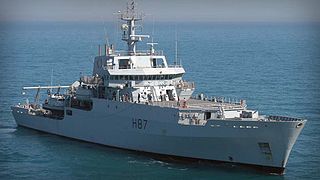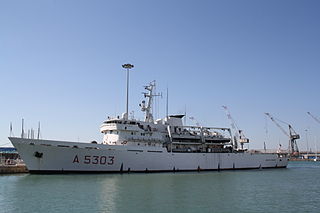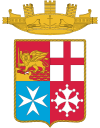
The Challenger Deep is the deepest-known point of the seabed of Earth, with a depth of 10,902–10,929 m (35,768–35,856 ft) by direct measurement from deep-diving submersibles, remotely operated underwater vehicles and benthic landers, and (sometimes) slightly more by sonar bathymetry.

Sonar is a technique that uses sound propagation to navigate, measure distances (ranging), communicate with or detect objects on or under the surface of the water, such as other vessels. Two types of technology share the name "sonar": passive sonar is essentially listening for the sound made by vessels; active sonar is emitting pulses of sounds and listening for echoes. Sonar may be used as a means of acoustic location and of measurement of the echo characteristics of "targets" in the water. Acoustic location in air was used before the introduction of radar. Sonar may also be used for robot navigation, and SODAR is used for atmospheric investigations. The term sonar is also used for the equipment used to generate and receive the sound. The acoustic frequencies used in sonar systems vary from very low (infrasonic) to extremely high (ultrasonic). The study of underwater sound is known as underwater acoustics or hydroacoustics.

Side-scan sonar is a category of sonar system that is used to efficiently create an image of large areas of the sea floor.

Echo sounding or depth sounding is the use of sonar for ranging, normally to determine the depth of water (bathymetry). It involves transmitting acoustic waves into water and recording the time interval between emission and return of a pulse; the resulting time of flight, along with knowledge of the speed of sound in water, allows determining the distance between sonar and target. This information is then typically used for navigation purposes or in order to obtain depths for charting purposes.

Hydrographic survey is the science of measurement and description of features which affect maritime navigation, marine construction, dredging, offshore oil exploration/offshore oil drilling and related activities. Strong emphasis is placed on soundings, shorelines, tides, currents, seabed and submerged obstructions that relate to the previously mentioned activities. The term hydrography is used synonymously to describe maritime cartography, which in the final stages of the hydrographic process uses the raw data collected through hydrographic survey into information usable by the end user.

The Echo class is a class of multi-purpose hydrographic survey ships in commission with the Royal Navy. The ships are primarily tasked with conducting survey work in support of submarine and amphibious operations, however, the class also has a secondary role in mine countermeasures. The two vessels of the class were the most recent additions to the Royal Navy's Hydrographic Squadron. Each ship displaces approximately 3,700 tonnes, and is equipped with a state of the art suite of equipment, though the lead ship of the class, HMS Echo was retired in 2022.

The Italian Navy is the navy of the Italian Republic. It is one of the four branches of Italian Armed Forces and was formed in 1946 from what remained of the Regia Marina after World War II. As of August 2014, the Italian Navy had a strength of 30,923 active personnel, with approximately 184 vessels in service, including minor auxiliary vessels. It is considered a multiregional and a blue-water navy.

A multibeam echosounder (MBES) is a type of sonar that is used to map the seabed. It emits acoustic waves in a fan shape beneath its transceiver. The time it takes for the sound waves to reflect off the seabed and return to the receiver is used to calculate the water depth. Unlike other sonars and echo sounders, MBES uses beamforming to extract directional information from the returning soundwaves, producing a swath of depth soundings from a single ping.

NOAAS Thomas Jefferson is a National Oceanic and Atmospheric Administration (NOAA) hydrographic survey vessel in service since 2003. The ship was built for the United States Navy as USNS Littlehales (T-AGS-52) serving as one of two new coastal hydrographic survey vessels from 1992 until transfer to NOAA in 2003 when it was named after Founding Father and third U.S. president, Thomas Jefferson.
Acoustic survey in fishing is one of the research methods that can detect the abundance of target species using acoustic detectors. For example, many pelagic fisheries are generally very scattered over a broad ocean and difficult to detect. Hence survey vessel with acoustic detector emits sound waves to estimate the density of plankton and fish shoal. Generally, the transducer is put under water, which is linked to an echo sounder in the vessel which records the shoals of fish as "marks" on a screen or paper trace. Then the density and number of marks are converted into biomass.

The Sandhayak-class survey ships are a series of eight vessels built by Garden Reach Shipbuilders and Engineers (GRSE), Kolkata and Goa Shipyard, Ltd., Vasco for the Indian Navy. While Sandhayak, Investigator, Nirdeshak, Nirupak were built in GRSE; Sarveshak, Jamuna, Darshak, Sutlej were built by Goa Shipyard. The vessels equipped with four survey motor boats, two small boats and are powered by two diesel engines with a top speed of 16 knots. They have a helicopter deck and are also armed with a Bofors 40 mm/60 gun mount for self-defense.
The RV Denar 2 is a Turkish research and survey vessel owned by TOMA Maritime S.A. Istanbul, Turkey and operated 2E Maritime in Istanbul, Turkey.

Anteo is a submarine rescue ship of the Italian Navy, assigned to Raggruppamento Subacquei ed Incursori "Teseo Tesei" (COMSUBIN). Anteo is the third ship to bear this name in the Italian Navy. The ship's design was developed by the "Ufficio Navi Speciali del Reparto Progetti Navi", according to the guidelines provided by the Navy General Staff. The ship was built at Cantiere Navale Breda di Porto Marghera and commissioned to the Italian Navy on 31 July 1980.

Ammiraglio Magnaghi is a hydrographic survey vessel in service with Italian Navy.
It's the first survey vessel ever to be designed and built completely in Italy for the Marina Militare. It has been regularly modernized and constantly upgraded.

Alliance (A5345) is a research vessel owned by NATO and operated by the Marina Militare as a NATO research vessel and owned by the CMRE – Centre for Maritime Research and Experimentation, in La Spezia, Italy. Alliance has the status of an auxiliary ship of the Marina Militare.
The Marino class of diving support vessels consists of two units operated by the Italian Marina Militare. The vessels are used by Comando Subacquei Incursori (COMSUBIN) for training and operational duties and are named MAS Motoscafo Appoggio Subacquei.

SRV-300 is a deep-submergence rescue vehicle that is rated to dive up to 300 m (980 ft). It was built by DRASS (Livorno) for the Marina Militare, and is capable of descending to 300 metres (980 ft) carrying 12 passengers in addition to crew. SRV-300 is hosted by Anteo, berthed at La Spezia.

Leonardo is a coastal research vessel owned by NATO and operated by the Italian Navy on behalf of the Centre for Maritime Research and Experimentation Her homeport is La Spezia, Italy.
USSP is a planned Submarine rescue ship of the Marina Militare, financed with 2017's balance law.
It is expected to replace Italian ship Anteo.
The following is the structure of the Italian Navy as of June 2020. It is considered a multiregional and a blue-water navy.
















